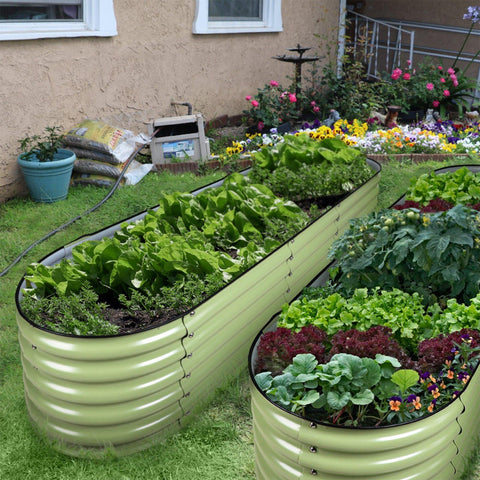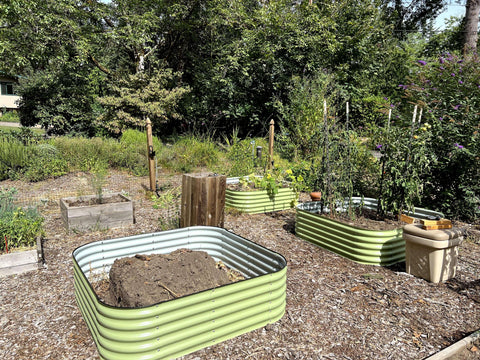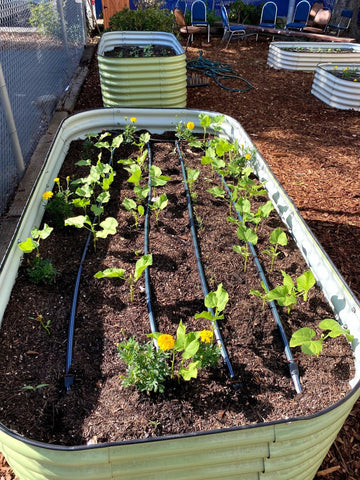5 Effective Methods to Improve Garden Soil Structure and Texture
Good soil structure and texture are key factors in maintaining a healthy and thriving garden. High-quality soil provides the necessary nutrients, water, and oxygen for plants and promotes root growth and development, especially in raised garden beds. However, many garden soils suffer from loose structure and poor texture, which negatively impact plant growth and development. This article will introduce five effective methods to help improve the structure and texture of garden soil, allowing your garden to thrive.
In this article, we will explore five methods to enhance soil texture and structure. These techniques benefit both the soil and the environment, as they encourage sustainable agriculture.
Five methods to improve soil structure and texture in raised garden beds:
1.Composting
Composting is a simple and primitive method of naturally enhancing soil quality. It's all about breaking down organic matter such as vegetable and fruit scraps, leaves, grass clippings, and manure into nutrient-rich humus that you can add to the soil, making it richer and more fertile.
Making compost is a delicate dance between adding high-nitrogen things like kitchen scraps and freshly cut grass and materials with high carbon content like dry leaves and straw. You also need to add water and ensure plenty of oxygen around. Nitrogen-rich materials act as snacks for the microbes, aiding in the decomposition process, while carbon-rich materials provide the fibers they need to do their job properly.
How to make a compost bin?
To start making compost, you can grab a compost bin or simply throw a pile of stuff in your yard. A mix of nitrogen and carbon-heavy materials, along with some chunks of soil, and a moist, well-ventilated pile will get the decomposition process started. It's best to keep the pile at a temperature around 120°F to 160°F and turn it to allow air in.
As organic matter decomposes, it transforms into humus, a dark, crumbly material rich in beneficial microbes, with a pleasant earthy smell. This humus is a true game-changer for soil—it can be added to make the soil more fertile and resilient. For example, it will enhance the soil's water-holding capacity (which you can check using a soil moisture sensor) and provide the necessary nutrients for plants.
Composting can be an awe-inspiring and imaginative process, and there are many ways to make it fun. To speed up the decomposition process, you can introduce worms and create a worm sanctuary. You can also add compostable materials like coffee grounds, tea leaves, or eggshells to provide excellent nutrition to the compost pile.
2.Cover cropping
Cover cropping is a wise practice to keep the soil healthy and secure, protecting your garden beds from extreme weather conditions. It involves planting crops that are not intended for harvesting but rather to prevent soil erosion, nutrient leaching, and resist other environmental elements.
Typically done in autumn or winter, cover cropping continues until spring or summer, depending on the crop type and weather conditions in your area. Legumes like clover and peas, as well as grasses like rye and oats, are the most commonly used cover crops.
Legumes have gained popularity among farmers as they associate plants with good things through nitrogen-fixing bacteria. This helps keep the soil fertile and healthy, and the additional benefits of extra organic matter further promote soil health.
On the other hand, grasses know how to keep things in place. Their roots tightly anchor the soil, helping it retain nutrients and moisture. They are the go-to choice for anyone concerned about soil erosion or looking for a sturdy soil structure. Besides being beneficial for the soil, cover crops can also beautify your garden in an interesting way.
You can mix and match different types of cover crops to create vibrant and trendy ground covers. Alternatively, if you want to attract friendly insects, you can plant specific cover crops to lure bees, butterflies, and ladybugs.
3.Crop rotation
Crop rotation is a timeless farming technique that involves planting different crops in the same field during different seasons. The primary purpose is to improve soil fertility, prevent erosion and diseases, and protect soil composition. If you're growing in raised garden beds, the same plant family should be rotated in the next growing season.
The benefit of crop rotation is that it prevents the loss of soil nutrients. Different crops require different nutrients; therefore, crop rotation allows farmers to maintain soil rich in all the necessary nutrients. For example, legumes and peas are nitrogen-fixing legumes that help deposit nitrogen back into the soil, aiding the subsequent growth of crops like corn or wheat.
Additionally, crop rotation helps curb soil-borne diseases. When the same crop is planted year after year, soil-borne pests accumulate in the soil, affecting the crops. By alternating the crops, farmers can reduce the chances of soil-borne diseases attacking the plants. For example, farmers can alternate between crops like cucumbers or peppers and tomatoes, which are susceptible to soil-borne diseases, to minimize the chances of infection.
4.Tilling and loosening the soil
Regular tilling and loosening of the soil are important steps in improving garden soil structure and texture. Tilling breaks up soil clumps and compacted layers, increasing soil aeration and water permeability. Loosening the soil helps improve water drainage and root growth. However, it's important to note that excessive tilling and loosening can disrupt soil structure.
It's recommended to till or loosen the soil when it's neither too wet nor too dry. You can use a garden fork, a tiller, or a broadfork to break up the soil clumps and improve its structure. Avoid over-tilling, as it can disrupt beneficial soil organisms and lead to soil erosion. Regularly adding organic matter, like compost, during tilling can further enhance soil structure and texture.
5.Proper fertilization
Proper fertilization is a key measure to improve soil texture and structure. Understanding the nutrient requirements of plants and selecting appropriate fertilizer types and application methods can provide the necessary nutrients to plants and prevent soil degradation caused by excessive fertilization. Organic fertilizers such as compost and humus can improve soil texture, while inorganic fertilizers can supplement specific nutrient elements.
It's important to follow the recommended dosage and application instructions for fertilizers to avoid nutrient imbalances or environmental pollution. Conducting soil tests periodically can help determine the nutrient levels and pH of the soil, enabling adjustments and proper fertilization practices.

In summary, improving garden soil structure and texture is an ongoing process that requires patience and careful management. By adding organic matter, practicing cover cropping, implementing crop rotation, tilling and loosening the soil, and applying fertilizers appropriately, you can significantly improve the structure and texture of the soil, creating a favorable growth environment for plants. Regular monitoring of soil pH, nutrient levels, and moisture conditions allows for adjustments and effective management. Ultimately, you will achieve a fertile and healthy garden soil that fosters plant growth and prosperity.


